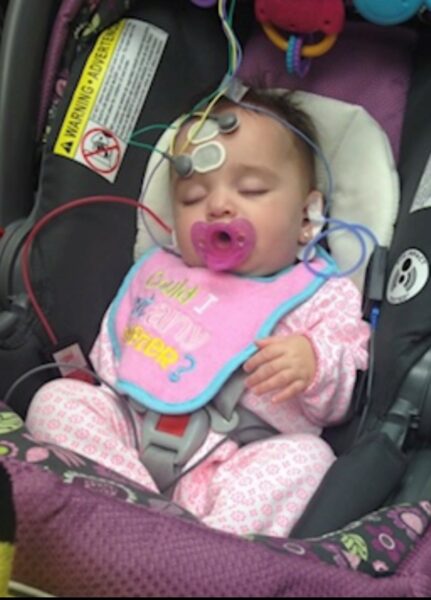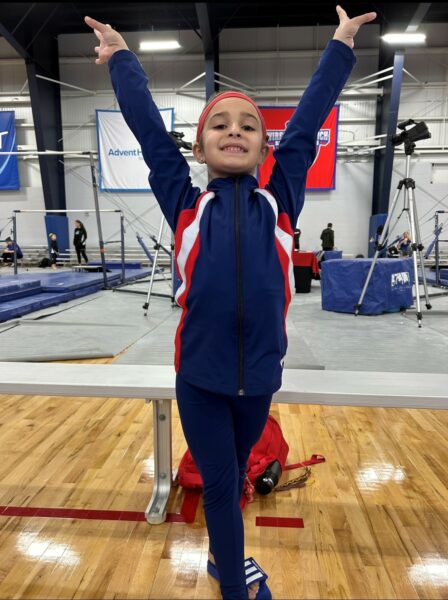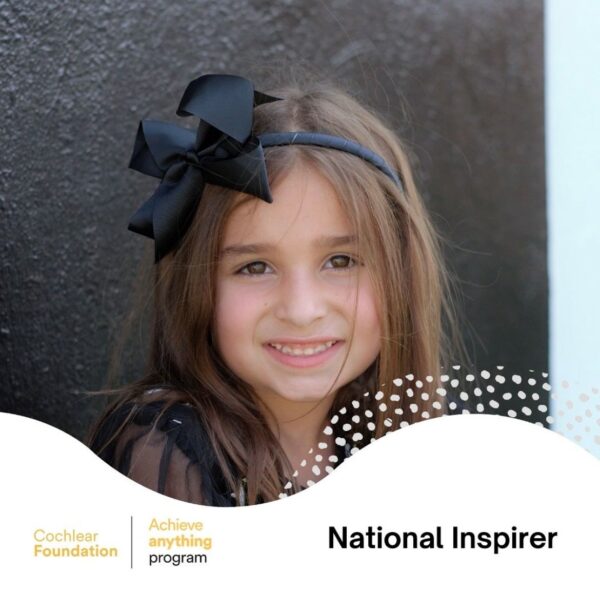When diagnosed with bilateral sensorineural hearing loss, Sophia’s family was shocked because they had no history of hearing loss in their family. After consulting with audiologists and researching the possibilities, they learned about cochlear implants. Sophia’s cochlear implants now help her hear while swimming, streaming music and participating in gymnastics. For more on Sophia’s hearing journey, read on:
“Upon birth, Sophia failed the newborn hearing screen on both ears and upon leaving the hospital, she failed only one. They thought it could be liquid from the birth but recommended I see an audiologist and an ear, nose and throat doctor (ENT). After doing an auditory brainstem response (ABR) test, it was confirmed she had bilateral sensorineural hearing loss in both ears. We were devastated to learn that the degree of her hearing loss was severe to profound. We had no history of hearing loss in our family and no complications during pregnancy.
Finding cochlear implants
 We found out from the audiologist about cochlear implants. After much research, we decided to have surgery for cochlear implants at 15 months old1. I was really hesitant to having the surgery, however, if I could go back, I would do it sooner. Surgery sounds more intimidating than it is. The kids are so resilient, the same night of surgery, Sophia was bouncing off the walls.
We found out from the audiologist about cochlear implants. After much research, we decided to have surgery for cochlear implants at 15 months old1. I was really hesitant to having the surgery, however, if I could go back, I would do it sooner. Surgery sounds more intimidating than it is. The kids are so resilient, the same night of surgery, Sophia was bouncing off the walls.
We then started to have speech therapy with her as well as an inclusion setting in school. By the time she was 5, she was in a mainstream school setting and up to the level as her peers. While she still falls behind in reading and language arts, we try to reinforce those subjects with additional therapy and tutoring. Now at 7, she continues to be fearless and enjoys spending her time competing in level 2 gymnastics. Hearing loss is not stopping her and although the journey seems endless, the ride is well worth it. She is unstoppable.
A choice for our child’s future
 We chose Cochlear because they were the first in the business. Their representatives were always so helpful and extremely responsive to any calls we had. We saw how user friendly the implants were to set up and the Aqua+2 was fascinating; we were thrilled to have her in swimming lessons and hearing! The technology Cochlear offers is important in this modern age.
We chose Cochlear because they were the first in the business. Their representatives were always so helpful and extremely responsive to any calls we had. We saw how user friendly the implants were to set up and the Aqua+2 was fascinating; we were thrilled to have her in swimming lessons and hearing! The technology Cochlear offers is important in this modern age.
We do notice when there are background noises she tends to have a hard time hearing. At home, every night, we charge 4 batteries and our processors in the humidifier. We carry 2 spare batteries since her left implant requires so much power. Her favorite part of the Cochlear™ Nucleus® 7 Sound Processor, is being able to stream3 music directly to her ears and can listen to something different. Her favorite part of having implants is disconnecting when she’s tired of hearing.”
 It was announced in 2022 that through the Cochlear Foundation’s Achieve Anything Program – whose goal is to inspire children and young people with hearing loss to share their personal stories of achievement – Sophia has been selected as a National Inspirer.
It was announced in 2022 that through the Cochlear Foundation’s Achieve Anything Program – whose goal is to inspire children and young people with hearing loss to share their personal stories of achievement – Sophia has been selected as a National Inspirer.
If your child has been diagnosed with hearing loss even with no history of hearing loss, cochlear implants may be a solution. Learn more about your options today.
- In the US, the cochlear implant system is intended for use in children 9 to 24 months of age who have bilateral profound sensorineural deafness and demonstrate limited benefit from appropriate binaural hearing aids. Children two years of age or older may demonstrate severe to profound hearing loss bilaterally. In Canada, the cochlear implant system is intended for use in children 12 to 24 months of age who have bilateral profound sensorineural deafness and demonstrate limited benefit from appropriate binaural hearing aids. Children two years of age or older may demonstrate severe to profound hearing loss bilaterally.
- The Nucleus 7 Sound Processor with Aqua+ is water resistant to level IP68 of the International Standard IEC60529. This water protection means that the sound processor with the Aqua+ can be continuously submerged under water to a depth of 3 meters (9 ft and 9 in) for up to 2 hours. This water protection only applies when you use a Cochlear Standard Rechargeable Battery Module or Cochlear Compact Rechargeable Battery Module. The Nucleus 7 Sound Processor is water-resistant to level IP57 of the International Standard IEC60529 without the Aqua+ accessory for the Nucleus 7 Sound Processor.
- For a full list of smartphone and app compatible devices, visit: www.cochlear.com/compatibility.